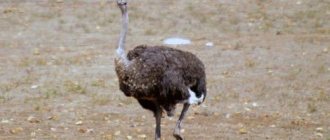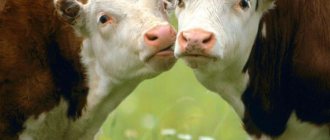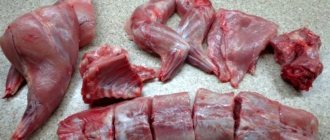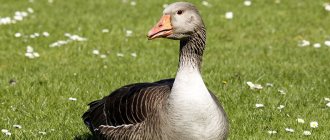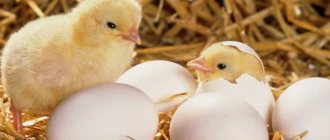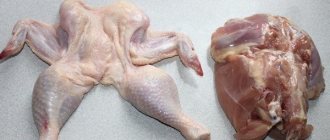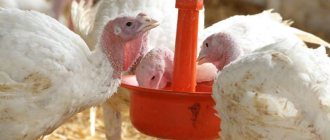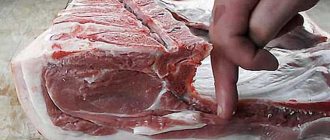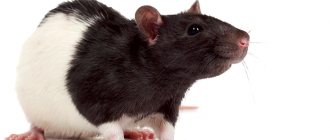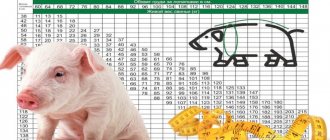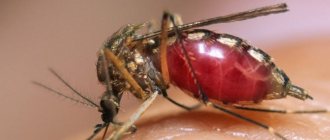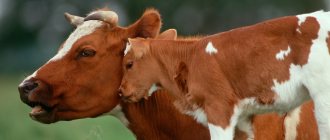Hello everyone, Olga is with you as always, perhaps you will need information on storing food and various things and I will tell you about deboning pork: types, technique, deboning standards and meat yield. Maybe some details may differ, as was the case with you. Attention, always read the instructions of the things you buy for cleaning the house or the chemicals that help to store them. I answer the simplest questions. Write your questions/wishes and secrets in the comments, and together we will improve and supplement the quality of the material provided.
Poultry meat yield:
The output of deboning broiler chickens with an emphasis on the production of boneless breast meat.
| name of raw materials | Percentage of yield to weight of broiler chickens, % |
| Ham leg n/a | 33% |
| Used breast | 20% |
| Wing n/a | 11,5% |
| Frames (including soup set) | 34,5% |
| Technological losses | 1% |
Deboning of broiler chickens with the production of all semi-finished poultry meat products on the bone.
| name of raw materials | Percentage of yield to weight of broiler chickens, % |
| Ham leg n/a | 33% |
| Breast n/a | 32% |
| Wing n/a | 11,5% |
| Frames (including soup set) | 22,5% |
| Technological losses | 1% |
When cutting broiler chickens, the frames could be sorted into a soup set as a ready-made semi-finished product, or chicken frames could be used for the production of mechanically deboned poultry meat.
Technological losses in a decent amount during deboning of poultry meat are due to the loss of meat juice and raw fat.
When deboning broilers, average data were obtained on the time consumption for deboning 100 kg of raw materials in the first case, the average value is 1 hour 10-20 minutes, in the second case around 1 hour.
Sincerely, Evgeniy Gorbunov.
Tags: reviews, technology, raw materials, portfolio, processing, production, meat, semi-finished products.
Did you like the article? Rate it by putting the appropriate star. Would you like to receive links to new articles by email “Subscribe to news”. Attention!!!
When quoting the text of articles and using any materials from the portal “Meat. Meat products. Food technologies." A link to the website https://foodteh.ru/ is required.
Broiler feed
It is important for poultry farmers to know how much feed they need to raise a broiler at home.
Feed consumption by age and estimated live weight gain
| Chick age | 1 day – 2 weeks | 2 weeks –1 month | 1–1.5 months |
| Feed consumption (g) | 15-80 | 80-120 | 120-180 |
| Average weight | 40 g-0.5 kg | 0.5-1.6 kg | 1.6-2.5 kg |
| Average growth (years) | 30 | 48 | 55 |
Broiler fattening follows a certain structure. In order for chickens to gain weight rapidly, it is necessary to ensure regular feeding and watering, according to the scheme: prestart - start - fattening - finish.
On a note. The proportion of water and feed in the birds’ diet is 1.7:1.
Liquid requirement:
Broiler feeding table before slaughter
For the effectiveness of the diet, it is important to remember the age of the bird. To understand how much feed a broiler eats before slaughter, you will need a table. It shows the number of chickens per day. The table allows you to control the standards for the successful rearing of birds.
Feeding broiler chickens
Within 5 days, the chicks consume 15 g of feed. After 5 days, the dosage is increased to 20 g. Starting from day 11 to 20, 45 g of feed is consumed daily. Then every 2 weeks the amount of feed increases by 20 g. A one-month-old chick eats 120 g.
Cost of cutting
Let's take a meat cutting shop as an example. Pork and beef half-carcasses are used as raw materials. Finished products are products of cutting half-carcasses: neck, ham, ribs, etc. Do not forget that as a result of cutting, waste is also formed, for example, bones.
Let’s say half-carcass pork is supplied to our workshop for 200 rubles per kilogram. We will also significantly simplify the cutting scheme. Suppose that as a result of cutting a pork half, we end up with 30% neck, 50% ham and 20% bones. Now the question is: what is the cost of the neck and other components of the half carcass?
I have come across several calculation options in books and on the Internet. For example, some propose to install special coefficients in the TTC. What part of the cost will fall on this or that part of the half carcass? Some suggest calculating these coefficients automatically, based on the average market price of these components. Both of these methods do not work unless the half carcass is cut completely. And in most cases, the piece that is needed right now is simply cut off from the half carcass, and the rest is left “hanging until better times.” It turns out that the cutting acts do not coincide with the Third Transport Code at all. Hence the erroneous determination of cost.
Who even said that the cost of a neck should be higher than the cost of a ham, shank, or even bones? Why are all economists trying in one way or another, in different synthetic ways, to make it different?
Tools
Pork is deboned at enterprises using knives, most often made of carbon steel with the addition of vanadium, molybdenum, and chromium. Such tools are durable and strong. It is believed that only knives with a hardness of at least 57 units on the Rockwell scale are suitable for boning.
The handles of such tools should also be durable and comfortable for workers. In Russia, enterprises most often use boning knives with wooden handles. Such a tool allows you to perform the operation with the highest quality possible. Wooden handles do not slip when wet. In addition, these knives have good balance. However, in some countries it is prohibited to use tools with such handles for boning. This is explained by the fact that with such knives it is difficult to clean the area in the area where the blade adjoins the wood, as well as the rivets. As a result, harmful microorganisms can grow in these places.
Slaughter yield of carcasses of different species of animals and birds
Of course, at first glance it seems that if a pork neck costs 350 rubles per kilogram in a store, and a knuckle costs 70, then the cost of their production should be different. But let's remember what cost is. This is the cost per unit of production. And our costs are 200 rubles per kilogram of a half carcass (for simplicity, we will neglect the wages of the hewers)!
From here we come to the conclusion that the cost of necks, shanks, bones, and lard is all equal to 200 rubles per kilogram.
Please note how easy it is to calculate income from sales of our cut. By selling a neck for 350 rubles, we receive 150 rubles in income. From selling ham we get 100 rubles in income, and by selling lard for 50 rubles we get 150 rubles in loss per kilogram. Adding up all these numbers, you can easily get income from cutting a half carcass.
Don’t rush to throw tomatoes and say that we cannot sell lard at a loss! If you dig even deeper into an economics textbook, it becomes clear that the cost of raw materials is the cost of alternative use of raw materials. What is the alternative to selling lard for 50 rubles? If you don’t sell it, but keep it in storage, you will lose those 50 rubles and earn nothing at all. Therefore, you can sell.
By the age of forty, Horland Sanders had worked as a washer, fireman, insurance agent, miner, tram conductor, and furniture loader. He didn't have a regular job or his own home, but he had a recipe for chicken fried in a mixture of herbs and spices. One day, Horland Sanders heard a humorous radio program about how “life after forty is just beginning.”
He later said that these words changed his life. Sanders opened a small auto repair shop on the side of the interstate. In the cafe at the auto repair shop, if you can call it that, a small room with one table and a few chairs, the menu was based on fried chicken dishes. This began the story of the creation of the KFC company, which now has more than 18,000 restaurants around the world, and the chicken recipe has become one of the best-kept culinary secrets in the world.
You can have different attitudes towards fast food, but it is a fact that chicken meat makes up a significant part of the meat diet in most families . What would a holiday table be without chicken baked in the oven until golden brown? Grilled wings, breasts in sauce, fried legs, and “medicinal” chicken broth? Everyone has their own favorite dish.
To produce chicken meat, poultry farms use broiler chickens, and when we buy broiler chicken meat in a store, we don’t even think about where this name came from, why this particular breed is used for breeding, and how much meat comes out of a cut broiler carcass.
Broilers are two-month-old chickens that are raised for meat. Broil translated from English means “to fry, to fry . One of the important qualities of this breed is early maturity - at the age of two months, chickens can reach a weight of up to 2.5 kilograms . The absence of dark skin and dark feathers are also important marketable qualities. After two months of age, chicken growth and weight gain slows down, and the bird must be slaughtered.
For a gutted chicken, the meat yield is approximately 60%, the bones account for 10 - 15%, in total, answering the question of how much meat comes out of a cut broiler carcass, we can talk about a value of 50% of the pre-slaughter weight of the bird . It’s not difficult to calculate that if you buy a gutted chicken weighing 1 kg, you can get 800-900 grams.
Body-building. How to quickly build muscle?!
The author wished to remain in the shadows, so only the initials V.K. I have always been drawn to research, in a variety of fields.
Yesterday I became interested in which of the products, sources of protein, are most profitable to buy. I started analyzing my food basket with chicken. If in the table of products we pay attention to the parameters of different chicken meat (proteins, fats, carbohydrates, calorie content), then it will make it clear to us that brisket fillet is the leanest and most protein-rich meat. But we all know that the price of a brisket fillet is one and a half times more than the price of a whole chicken. Just ask any woman and she will tell you that buying a whole chicken is the most profitable. But is this really so? More precisely, is this rule suitable for athletes?
On the path to the truth, yesterday, I successfully conducted my first research. I bought a chicken. Weighed it. 1980 grams. Rubbed it with different spices and dressings. I baked it in the oven for an hour and a half. Cooled it down. I cleaned it of dressings and external excesses in the form of spices. And he weighed it!.. The weight of the chicken after baking decreased by 501 grams! The mass of the finished product was 1479 grams, that is, in comparison with the mass of raw chicken, at this stage we incurred conditional losses in the form of 25% of the chicken’s mass. Next comes the fun part! Within 15 minutes I was disassembling the chicken, which was not yet sufficiently cooled inside. I decided to separate and weigh separately the meat, skin and edible cartilage, as well as the bones. The most difficult part of this process was not that the hot chicken burned my fingers, but that I did all this at six in the evening, and it so happened that that day I didn’t have time to eat anything at all, and usually I lick my food well. The chicken intoxicated and intoxicated me with its aroma, but I was as persistent as ever, for great science requires great sacrifices!
As planned, the result of my “torment” was three plates: with meat, with skin and edible cartilage, as well as a plate of bones. During autopsy, no other foreign objects or tissues were found in the body of the chicken... The total weight of the bones was 217 grams, which corresponds to 11% of the weight of a raw whole chicken. The total weight of the skin including edible cartilage was 254 grams, which corresponds to 13% of the raw weight of the whole chicken. And the total weight of ready-to-eat meat... drums... was 927 grams, which corresponds to 47% of the weight of a raw whole chicken.
Now all we have to do is properly manage the available data.
First, we can quite accurately determine the relative real cost of one kilogram of a finished product that we really need - meat, in the case of buying a whole chicken. For 1 kg 980 grams of raw product in the form of a whole chicken, I paid 43 UAH. 55 kopecks, after cooking which we got 927 grams of meat. This means that a kilogram of clean meat cost me (43 UAH. 55 kopecks) divided by (0.927 kg) equals 47 UAH. without three kopecks.
Secondly, from the data obtained we can calculate for ourselves the cost of one gram of protein. It is generally accepted that 100 grams of chicken of the first category contains 18.2 grams of protein, 18.4 grams of fat, 0.7 grams of carbohydrates and all this together gives 241 kcal. In turn, 100 grams of chicken fillet contains 23.6 grams of protein, only 1.9 grams of fat and 0.4 grams of carbohydrates, and all this provides only 113 kcal. Taking into account the specifics of our cooking method, and during the baking process fats are smelted and displaced from the chicken to the bottom of the dish, we can assume that in this case, due to the displacement of excess moisture and fats, we will obtain the amount of protein in the chicken at the level of 20 grams per 100 grams of the finished product, and due to the displacement of fats, the calorie content of the finished meat will decrease by a tenth (200 grams), which is exactly how much juice I was able to collect from the chicken. But the latter is not so important yet. As a result, 20 grams of protein will cost us 4 UAH. 70 kopecks, and 100 grams of protein costs 23 UAH. 50 kopecks respectively. Thus, the rate of protein in “whole chicken-meat” currency will be 24 kopecks per 1 gram of protein. For the socially and environmentally oriented population, it was necessary to additionally calculate the costs of gas and electricity, but these have been missed here for now.
Third, now from all this we can calculate the budget and determine for ourselves the size of the chicken we need for a certain period of consumption. Everything here is very individual. At least a topic for a new article or even for writing a calculator for the site.
Fourth, we can compare the economic feasibility of investing in other products, for example, eggs, cottage cheese, in order to achieve the optimal amount of protein consumed per day per kilogram of your weight. The average cost of eggs is 96 kopecks. a piece. One egg without a shell will weigh on average 50 grams and contain 6.35 grams of protein, so the price for 1 gram of protein in an egg will be 15 kopecks. Quite a few articles have been written about how best to cook eggs and eat them, but I’ll just add that if your workout ends at 10 pm and you’re very tired, going to bed and don’t want to overload yourself with food and liquids, eat 2- 4 soft-boiled eggs would be a very good option for providing the body with the necessary building materials and energy. Next, let's move on to analyzing the cost of cottage cheese. The cost of cottage cheese, let’s take for example “Slov’yanochka Domashniy low-fat fermented milk cheese 230 grams” is 9 UAH. 97 kopecks, according to what is stated on the packaging, it can be judged that 100 grams of this product contains 18 grams of proteins, 0.2 grams of fat, 1.8 grams of carbohydrates, and the energy value is 81 Kcal. Turn on the math, 100 grams of cottage cheese equals 4 UAH. 33 kopecks, so 1 gram of protein in cottage cheese will cost us the same 24 kopecks as a whole chicken.
Fifth, looking ahead, and not yet having exact data, I plan to get it next week, 1 kilogram of chicken fillet will cost an average of 35 hryvnia, and the processing process, drawing a parallel from the results of cooking a whole chicken, due to the lower water content and practically no fat will lead to the loss of a much smaller amount of that 25% wet weight on the finished product. The figure will definitely be below 20% and possibly below 15%. Thus, 35 UAH. divided by 0.825 will give a price of 42 UAH. 42 kopecks per kilogram. Based on the fact that chicken fillet contains 23.6 grams of protein per 100 grams of product, it will not be difficult to calculate the new rate, which will be 18 kopecks. per gram of protein in chicken fillet.
What conclusions can we draw from all this?
The most cost-effective product today in terms of protein production. eat eggs, the cost of one gram of protein in an egg is 15 kopecks, but it is important to remember that eggs are a source of cholesterol, so it is definitely not recommended to live on eggs alone. Second place, although this has not yet been conclusively proven, goes to chicken fillet - 18 kopecks. per kilogram. Third place goes to low-fat cottage cheese and whole chicken - 24 kopecks per 1 gram.
I also plan to do the same analysis for veal, pork and fish.
If the post was useful to you, click the +1 button or any other. It’s not hard for you, but it’s a bonus for me! Thank you!:) Below you can leave a comment on this article. You can subscribe and receive site updates by email.
| Pre-workout nutrition for a bodybuilder | Protein-carbohydrate window |
- Georgy writes: March 29, 2013 at 10:17 am
Good article, thank you) - a novice bodybuilder writes: Jan 16, 2014 at 1:44 am
Interesting analysis. It can also be clarified by the fact that homemade cottage cheese bought at the market will cost much less than packaged cottage cheese in a supermarket. And the fact that he is a little fatter is not critical if you are a weakling who strives to gain weight.
Meat yield from chicken when cutting
meat pulp.
By the way, in 2016, the nephew of Harland Sanders' second wife shared a secret recipe for making KFC fried chicken; according to him, he found a recipe of 11 spices and herbs in his aunt's old papers. Now everyone can try the most secret culinary recipe at home and perhaps someone will have another favorite dish on their home menu.
This entry was posted in the Poultry Meat section and tagged Bird Anatomy. Bookmark the permalink.
Answers to common questions
Most poultry farmers' questions relate to choosing the appropriate breed and age at which to slaughter the bird.
Broilers are slaughtered at about 50 days of age.
What is the slaughter weight of broiler chickens?
Broilers are slaughtered at the age of about 50 days , less often at a later date. A bird that reaches 70 days stops gaining weight and there is no point in raising it any further.
It is better to slaughter when the chicken is sufficiently feathered , then the carcass will become cleaner and easier to pluck.
By the time of slaughter, a chicken reaches a weight of approximately 2.7-3 kg , some birds of especially meat breeds - up to 5 kg. Approximately 17-18% of the mass falls on the pectoral muscles, 9-10% on the thigh muscles, 6.5% on the lower leg.
What breed of broiler is the largest and meatiest?
All birds reach impressive dimensions by the time they are slaughtered, but they also have their own leaders.
It is best to slaughter when the chick is sufficiently fledged.
The largest breeds include:
- Ross-308 . By the age of 2 months, the individual reaches an average weight of about 2.5 kg, the maximum possible weight is 5.5-6 kg. Meat yield during cutting is up to 74%. The breast is wider and meatier than that of representatives of the Koob breed, but Rosses have weaker immunity. The color of the skin and flesh is pale. They have good egg production.
- Ross-708. It is characterized by high early maturity. By 1 month of life, the bird reaches a weight of 2.5-3 kg. The body is squat and powerful. The color of the skin and meat is yellowish; if slaughter is carried out at an early age, the tone is light. Good egg production.
- Koob-500. Chickens reach 2-2.5 kg by the 6th week of life. The meat and skin of representatives of the breed are not pale, but have a more natural yellowish tone. They are distinguished by a wide chest and powerful legs. Survival due to the body's resistance to disease reaches 98%. Exclusively meat breed.
- Hubard. By 2 months, individuals reach a weight of 2.7-3.2 kg, the maximum possible figure in adulthood is 8-10 kg. The body is medium in size, the chest is well defined, especially in females. Satisfactory egg production. Survival rate is up to 99%.
Schemes for cutting chickens to obtain natural semi-finished products
DS.03 TECHNOLOGY OF SEMI-FINISHED MEAT PRODUCTS
Practical lesson. Study of poultry cutting schemes for the production of semi-finished meat products
METHODOLOGICAL INSTRUCTIONS
Specialty 260301 Technology of meat and meat products
Ufa 2006
UDC 637
BBK 36.92
P 69
Recommended for publication by the methodological commission of the Faculty of Food Technologies (protocol No. 3 of October 25, 2006)
Compiled by: Art. Rev. A.R. Salikhov
Art. Rev. AND I. Gizatov
Reviewer: Associate Professor of the Department of VSE, Ph.D. A.M. Galiullina
Responsible for release: head. Department of TMM, Ph.D.,
prof. A.V. Savelyev
Ufa, BSAU, Department of Meat and Milk Technology
Purpose of the lesson: To study the schemes for cutting poultry carcasses to obtain semi-finished meat products.
Tasks:
— study the scheme of cutting chicken carcasses to obtain packaged meat and natural semi-finished products;
— study the scheme for cutting broiler chicken carcasses to obtain packaged meat and natural semi-finished products;
— study the scheme for cutting up waterfowl carcasses to obtain packaged meat and natural semi-finished products;
— study the scheme for cutting turkey carcasses and turkey poults to obtain packaged meat and natural semi-finished products
General information
For the production of semi-finished poultry products, carcasses of chickens, ducks, geese, and turkeys are used; for quick-frozen ready meals - chicken carcasses. Depending on the age of the bird, meat is divided into meat of young and adult birds. Young poultry meat includes the carcasses of chickens, broiler chickens, ducklings, goslings, and turkey poults with a non-ossified (cartilaginous) keel of the sternum, a non-keratinized beak, and soft plastic skin on the carcass.
On the legs of chicken carcasses, broiler chickens, and turkey poults there are smooth, dense, adjacent scales and spurs that are not developed in the form of tubercles; There is tender skin on the legs of ducklings and goslings. Adult poultry meat includes carcasses of chickens, ducks, geese, and turkeys with an ossified (hard) keel of the breastbone and a keratinized beak.
The young bird has a flexible, smooth, brightly colored crest with a pointed end. Ducklings have a flexible beak. An adult bird usually has a darker color, a rougher body, the end of the keel is dense, without cartilage.
Semi-gutted and gutted carcasses are supplied for the production of semi-finished products and ready-made quick-frozen poultry meat dishes. In semi-gutted carcasses, the intestines with the cloaca, the filled crop, and the oviduct (in females) have been removed.
Raw meat and its characteristics
For the production of semi-finished products, sausages and packaged products in Russia and Ukraine, beef, pork, chicken and, less often, lamb, horse meat, goat meat, and venison are most often used.
Meat is a collection of bone, muscle, connective, fatty and nervous tissues, as well as blood and lymphatic vessels. Its components are proteins, fats, minerals and water. Due to the presence of proteins in it, the product has high nutritional value, so proper deboning of the meat is very important, when the standing pulp is preserved as much as possible when it is separated from the bones.
Each type of meat has a different tissue ratio, for example, pork has a higher percentage of fat than beef. In general, the chemical composition of the product is influenced by the breed, age, sex and fatness of the animal. A small amount of fat in meat increases the value of the product. Thus, the most delicious piece is considered to be marbled meat, the muscle fibers of which have a fatty layer.
Meat yield
Gutted carcasses have all internal organs removed, the head (between the 2nd and 3rd cervical vertebrae), neck (without skin) at the level of the shoulder joints, legs up to the tarsal joint or below it (but not more than 20 mm). The internal fat of the lower abdomen remains on the carcass. Usually the lungs and kidneys remain on the carcasses.
Depending on the temperature in the thickness of the pectoral muscles, poultry carcasses are divided into cooled (temperature no higher than 25 ° C), chilled (temperature from 0 to 4 ° C) and frozen (temperature no higher than –8 ° C).
Based on fatness and carcass processing, birds of all types are divided into two categories: first and second. The fatness of a bird is determined by the state of the muscular system (muscle development) and the presence of fat deposits on the surface of the carcass. The quality of poultry processing is assessed by the degree of feather removal (cleanliness of processing), the condition and type of skin, and the condition of the skeletal system. Poultry carcasses that meet the requirements of the first category in terms of fatness, and the requirements of the second category in terms of processing quality, are classified as the second category.
Carcasses of the first category of all types of poultry have well-developed muscles, the chest is round in shape, the keel of the breast bone does not stand out, with the exception of carcasses of chickens and turkey poults. Deposits of subcutaneous fat on the carcasses of adult birds are on the chest, belly and back; on the back of chicken and turkey carcasses - in the form of a continuous stripe, on geese carcasses - significant, including under the wings, on broiler chicken carcasses - insignificant in the lower abdomen (in addition, on chicken carcasses - in the form of an intermittent stripe on the back) , on the carcasses of ducklings and turkey poults - on the chest and belly.
Carcasses of the second category of all types of poultry have satisfactorily developed muscles, the chest is angular in shape, the keel of the breast bone can stand out; There should be slight deposits of fat in the lower abdomen and back, but may be absent if the muscles are satisfactorily developed.
Poultry carcasses that do not meet the fatness requirements of the second category are classified as lean.
Each bird carcass is marked with electromarking. The mark (for the first category - number 1, for the second category - number 2) is applied to the outer surface of the leg: for chicken carcasses, broiler chickens, guinea fowl, hens, ducklings, guinea fowl - on one leg; for carcasses of ducks, goslings, geese, poults and turkeys - on both legs. Poultry carcasses subject to industrial processing are marked with a “P” electrical mark on the back. The height of the numbers and letters of the stamps is 20 mm.
The transport container must have a stencil or label indicating the manufacturer, subordination, trademark, symbol of the type of poultry, category and method of processing poultry carcasses, number of carcasses, net and gross weight, date of production and designation of the standard.
Symbols for poultry carcasses. By type and age: chickens - C, broiler chickens - CB, hens - K, ducklings - UM, ducks - U, goslings - GM, geese - G, turkey poults - IM, turkeys - I, guinea fowl - SM, guinea fowl - C .
By processing method (after the symbol of the type of bird): semi-gutted - E, gutted - EE, gutted with a set of giblets and neck - R.
By fatness (after the symbol of the processing method): first, category - 1, second category - 2; not corresponding in terms of fatness of the first and second categories (skinny) - T. Containers of poultry meat sent for industrial processing
Schemes for cutting chickens to obtain natural semi-finished products
Chicken meat is used to produce: chicken fillet with bone; chicken leg; chicken broth set; chicken carcass prepared for cooking (Table 1).
To produce semi-finished products from chicken meat, gutted and semi-gutted carcasses of chickens of categories I and II are used, chilled and frozen, with a shelf life in a refrigerated state of no more than 3 days, in ice cream - no more than 2 months.
Table 1 – Assortment and characteristics of natural semi-finished chicken meat products
| Semifinished | Characteristics of the semi-finished product | Portion weight, g |
| Carcass prepared for cooking | Gutted carcasses from which the wings up to the elbow joint, part of the skin, lungs and kidneys have been removed. Internal fat has been removed. The site of neck separation is covered with a piece of skin tucked into the hole formed after removal of the goiter, trachea and esophagus. The tarsal joints are tucked into pockets. Skin surface without stumps and hair-like feathers | Product by weight |
| Fillet | The pectoral muscles are oval in shape with a superficial film, without skin. The tendon between the major and medial muscles was cut two or three meters away, and it was removed from the minor muscle. The edges are smooth, without deep cuts. | 250, 500 or from 200 to 1000 |
| Fillet with bone | The pectoral muscles are oval in shape with a superficial film, without skin, with a humerus bone 3-4 cm long freed from pulp and a chopped off part of the head of the shoulder joint. The tendon between the major and medial muscles was cut two or three meters away, and it was removed from the minor muscle. The edges are smooth, without deep cuts. | 250, 500 or from 200 to 1000 |
| Ham | A part of a carcass consisting of the femur, tibia and fibula with adjacent muscles and skin. Skin surface without stumps and hair-like feathers | 250, 500 or from 200 to 1000 |
| Broth set | The part of one or more carcasses remaining after the separation of fillets and legs, including trimmings from the processing of fillets and fillets with bone. The surface of the skin of the remaining parts is without stumps and hair-like feathers | 500, 700, 1000 or from 200 to 1000 |
To obtain natural semi-finished products, chicken carcasses are cut according to the scheme presented in Figure 2.1. At the same time, there are two options for selecting carcass parts to obtain natural semi-finished products:
– in the first case, the breast, quarters, and soup set are isolated;
- in the second - breast, legs, soup set.
Yield rates for these cutting options are presented in Table 2.
But it should be taken into account that the given cutting schemes are not the only possible ones and used at all poultry processing enterprises. There are many ways to cut chicken carcasses, mainly differing from each other in the different set of separated parts and their percentage in the total mass of the carcass.
One of these options for cutting and isolating natural semi-finished products from chicken carcasses is presented in Table 3.
Figure 2.1 Cutting chickens to obtain natural semi-finished products: A-A - line for separating the dorsal-scapular part; B-B - line of division of quarters; 1 - breast; 2 - legs; 3 – dorsal part; 4 – wings
Table 2 - Names of natural semi-finished products and their yield from chicken carcasses
| Name of carcass parts | Yield of parts, % of carcass weight | |
| Method I | II method | |
| Breast | 23,4 | 25,4 |
| Ham | — | 33,7 |
| Quarter | 49,2 | — |
| Soup set | 26,4 | 39,9 |
| Technological losses | 0,7 | 0,7 |
| Technical waste | 0,3 | 0,3 |
Table 3 - Names of natural semi-finished products and their yield from chicken carcasses with an alternative cutting option
| Part name | Yield rate, wt.% carcasses | Assortment of semi-finished poultry meat products |
| Fillet | 22,3 | skinless fillet, escalope, goulash, stew |
| large fillet | 17,5 | large fillet |
| small fillet | 4,8 | small fillet |
| Ham, including: | 29,5 | ham, ham crote, goulash, stew |
| shin | 15,7 | drumstick, drumstick crote, stewing meat |
| hip | 13,8 | thigh, thigh crote, entrecote |
| Chicken wing, including: | 12,6 | wing (whole) |
| shoulder part of the wing | 6,1 | shoulder part of the wing |
| ulnar part of the wing | 6,5 | ulnar part of the wing |
| Broth set | 32,5 | quarter (hind), chicken tail |
| Neck skin | 2,1 | neck skin for stuffing |
| Technological losses | 0,7 | |
| Technical waste | 0,3 |
Table of weight gain by day
The gain of live body weight of broilers by day depends on the breed, sex of the bird, and conditions of detention. The weight gain of hens is slower than that of roosters.
On average, the weight should correspond to the following indicators:
| Age, days | Weight, grams |
| 40-45 | |
| 1 | 50-60 |
| 2 | 65-80 |
| 3 | 85-95 |
| 4 | 100-115 |
| 5 | 120-135 |
| 6 | 140-165 |
| 7 | 170-190 |
| 8 | 200-220 |
| 9 | 230-250 |
| 10 | 260-280 |
| 11 | 300-325 |
| 12 | 345-370 |
| 13 | 380-420 |
| 14 | 440-460 |
| 15 | 485-520 |
| 16 | 540-565 |
| 17 | 580-630 |
| 18 | 650-690 |
| 19 | 720-750 |
| 20 | 780-820 |
| 21 | 850-890 |
| 22 | 920-970 |
| 23 | 1 000-1 030 |
| 24 | 1 070-1 100 |
| 25 | 1 150-1 200 |
| 26 | 1 230-1 270 |
| 27 | 1 300-1 350 |
| 28 | 1 400-1 450 |
| 29 | 1 480-1 500 |
| 30 | 1 550-1 580 |
| 45 | 2 000-2 500 |
| 60 | 2 500-3 000 |
Slaughter weight
Slaughter weight (weight) in cattle is the weight of the carcass without skin, head, entrails and lower parts of the legs.
The slaughter weight for sheep is the weight of the carcass without entrails and lower parts of the legs, and for pigs without bristles.
In poultry, the slaughter weight depends on the characteristics of the post-slaughter processing of the carcass: in uneviscerated poultry it is the highest, since it includes the weight of the bloodless and plucked carcass with fat, head, legs and internal organs; for semi-gutted - the mass of the carcass with fat, but without intestines; with complete evisceration, not only blood, feathers, fluff and intestines are removed; but also all internal organs, also the head to the second cervical vertebra, legs to the tarsus and wings to the elbow joint.
Causes of poor weight gain
Sometimes the bird’s body weight growth lags behind the established standards.
Gain of live body weight of broilers by day depends on the breed
The reasons for the situation may be related to:
- insufficient caloric content of feed;
- poor quality of food ingredients;
- low temperature in the room or its changes, when energy is spent on heating the body;
- lack of lighting (should be around the clock for chickens under 1 month old, for older ones - 14 hours a day);
- large walking area (calories consumed are burned when moving);
- vitamin deficiency;
- damage by helminths or infectious diseases;
- lack of a meal schedule, which disrupts metabolic processes in the chickens’ bodies.
The room temperature at which the chicken is comfortable and the calories consumed are not spent on self-heating should be as follows:
- 0-14 days – +30 degrees;
- from 2 weeks – +25 degrees, with a decrease of 1-2 degrees every subsequent week.
The number of chickens is no more than 13-18 birds per 1 m², this will eliminate the waste of the energy value of the feed on unnecessary movements.
Cutting chicken: schemes, standards, technologies
They have increased early maturity, well-developed and fine-fiber muscles with desirable layers of fat, which give the meat juiciness and tenderness.
Rabbits are slaughtered in November-December after molting, when the hair becomes thick and shiny. Pre-slaughter fasting should be 12 hours with plenty of water provided. The most optimal age for slaughtering rabbits of all breeds is considered to be 110-130 days old, except for black-brown and gray giants. They are kept for up to 160 days.
When slaughtering chickens , ducks , geese , turkeys , the bird is taken by the head and the throat is cut 1.5-3 cm below the earlobe or ear (in waterfowl). The duration of bleeding is 1.5-3 minutes. Removing the feather and down covering from carcasses is very difficult. Thus, when processing poultry manually, labor costs for removing feathers account for 80% of all labor costs for processing the carcass. The quality of the carcass is directly dependent on the thoroughness of feather removal. If there are rips and scratches on the carcass, then the grade of such carcass is reduced regardless of its fatness. When removing feather cover, they also take into account the need to preserve the quality of the feather itself, especially down, which is a valuable raw material for the manufacture of various feather and down products.
The slaughter yield of chickens, geese, ducks and turkeys is 57 - 60%, and half-gutted 77 - 80%
Average slaughter yield of animals of different species
| Animal species | Slaughter yield % |
| Cattle | 55-66 |
| Sheep | 44-52 |
| Pigs | 75-85 |
| Horses | 47-52 |
table - average slaughter yield of animals
Indicators of slaughter and meat quality of bulls of different breeds (age 18 months)
| Breed | Simmental | Red Pied | Kazakh white-headed | Red steppe | Black and white | Kalmytskaya |
| 1 | 2 | 3 | 4 | 5 | 6 | 7 |
| Weight on farm, kg | 522,6 | 487,1 | 464,8 | 451,1 | 462,7 | 419,6 |
| Weight at the meat processing plant, kg | 514,3 | 479,8 | 455,1 | 442,4 | 454,4 | 407,9 |
| Transportation losses, kg | 8,3 | 7,3 | 9,7 | 8,7 | 8,3 | 11,7 |
| Carcass weight, kg | 278,6 | 253,5 | 253,5 | 235 | 236,4 | 222,3 |
| Carcass yield, % | 54,2 | 52,8 | 55,7 | 53,1 | 52 | 54,5 |
| Internal fat mass, kg | 12,1 | 10,7 | 13,2 | 11,5 | 8,7 | 12,3 |
| Yield of internal fat, % | 4,3 | 4,2 | 5,2 | 4,9 | 3,7 | 5,6 |
| Slaughter weight, kg | 290,7 | 264,2 | 2bb,7 | 246,5 | 245,2 | 234,7 |
| Slaughter yield, % | 56,5 | 55,1 | 58,6 | 55,7 | 54 | 57,5 |
| Internal fat yield relative to carcass | 4,3 | 4,2 | 5,2 | 4,9 | 3,7 | 5,6 |
table - indicators of slaughter and meat quality of bulls of different breeds
Meat qualities of pigs of different breed combinations
| Item no. | Breed combinations | Pre-slaughter weight, kg | Area of the muscle eye, cm2 | % fat | % meat | % bones | Meat index | Lean index |
| 1 | T | 100,5 | 43,7 | 18,3 | 69,05 | 12,65 | 5,46 | 3,77 |
| 2 | KBhLn | 100 | 49,1 | 22,9 | 64,1 | 12,75 | 5,02 | 2,79 |
| 3 | (KBxLn)D | 100 | 45 | 24 | 64,3 | 11,65 | 5,5 | 2,68 |
| 4 | (KBxLn)xPt | 100 | 51,1 | 28,25 | 60,85 | 10,75 | 5,66 | 2,15 |
| 5 | (KBxLn)xT | 101 | 50,5 | 25,5 | 64,6 | 9,9 | 6,5 | 2,53 |
| 6 | (KBx D)x Ln | 99,5 | 53,55 | 23 | 65,9 | 10,85 | 6 | 2,86 |
| 7 | (KBxD)xPt | 103 | 54,9 | 22,2 | 66,1 | 11,7 | 5,65 | 2,98 |
| 8 | (KBxD)xT | 101,5 | 50,85 | 19,4 | 68,8 | 11,8 | 6,19 | 3,55 |
| Average | 100,8 | 49,8 | 23 | 65,3 | 11,6 | 5,6 | 2,84 | |
table of meat qualities of pigs of different breed combinations
Slaughter yield of rabbit meat depending on age, %
| Breed | Age, days | |||
| 65 | 110 | 135 | 270 | |
| White giant | 46,2 | 53,2 | 59,8 | 60,0 |
| Gray giant | 45,4 | 53,4 | 59,2 | 59,1 |
| Black-brown | 46,4 | 52,3 | 57,5 | 57,9 |
| Silver | 51,5 | 54,9 | 58,6 | 53,1 |
| Vienna blue | 50,8 | 53,4 | 56,6 | 61,2 |
| Soviet chinchilla | 49,8 | 51,5 | 55,2 | 59,2 |
Conditions for fattening broilers for slaughter
Chickens for meat production are unpretentious, but their diet and maintenance determine their early maturity and weight.
The bird requires special feeding. To raise healthy chickens, feed is carefully selected and chicken growth programs are implemented.
It is important to comply with the requirements for keeping broiler chickens and care for them daily:
- Place. A poultry house is set up for the chickens, kept in cages or on litter.
- The thickness of the litter is a maximum of 10 cm and includes sawdust or other unpressed mass. 18 individuals are allowed to be kept per 1 m2.
- Temperature conditions. In the first week of life, the young animals are provided with a temperature in the range of +26...+33 °C, then reduced to +19...+18 °C.
- Illumination. The chicken coop is illuminated around the clock. The light is dim. The lamp power in the first week is 1.8 W per 1 m2, later 1.2 W - up to the 7th week of cultivation and at the end a 0.6 W lamp is used. Sometimes the brightness of the lighting is the root cause of pecking. Paint the lamp lamp in green or red tones.
- Purity. Regularly monitor and maintain order in the premises. Cleaning and changing of bedding are carried out systematically. To prevent gastrointestinal dysfunction in broilers, feeders and drinkers are washed with boiled water and disinfectants.
- Care. To protect against diseases, chickens are examined every day and fed in a balanced manner. Lethargic and disease-affected chickens are isolated from the livestock and treated.
Tips from chefs
Nuances
The carcass must be fresh. Thaw frozen chicken completely, rinse and dry. Use large knives to cut larger pieces. For removing meat from bones - small, with a thin blade. Serrated kitchen scissors will help you properly divide the carcass into pieces.
Wash your hands before and after handling meat. Wash tools with hot soapy water when finished. The cutting board cannot be used to cut other foods.
Recommendations
To make the dishes look beautiful, cut off the last phalanges (tips) of the wings. Pre-removing the tendons from the fillet will help make the finished chicken softer.
Store raw meat in the freezer separately from vegetables and fish. So that it cannot become saturated with their smells. For the same reason, raw poultry is kept on the bottom shelf in the refrigerator.
It is important to cut the chicken into pieces properly. And cook each part correctly to maximize the flavor. You can stuff the bird with vegetables, which are cut into pieces of different sizes, cereals, potatoes, cheese mixed with other ingredients.
